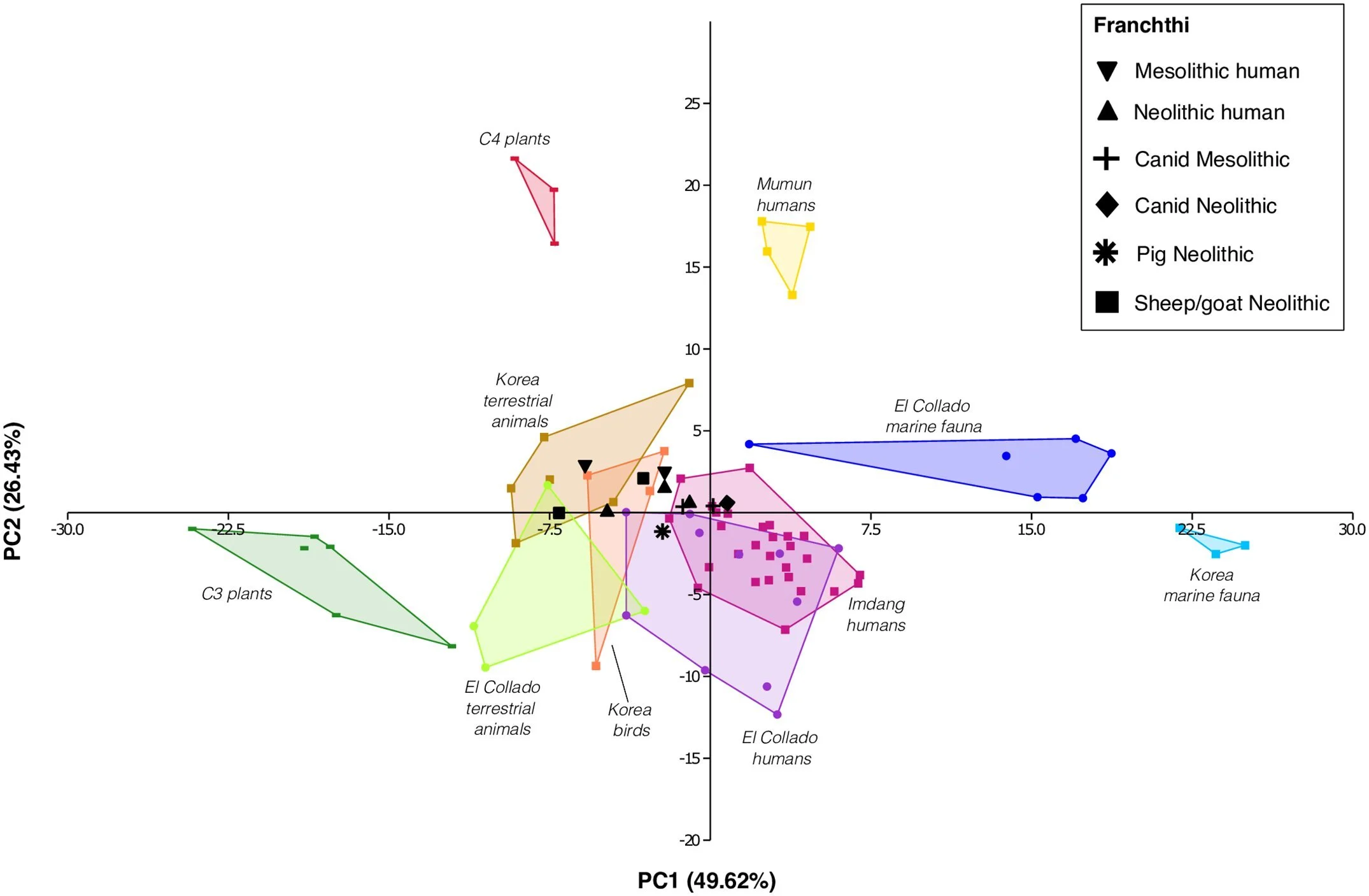Isotope Analysis Sheds Light on Prehistoric Greek Diets
By Justin Jackson, Phys.org
A recent study by Simon Fraser University, the Greek Ministry of Culture, and the University of Bologna has revealed new insights into the diets of Mesolithic and Neolithic populations at Franchthi Cave, Greece. Using high-resolution isotope analysis, researchers confirmed that these prehistoric humans relied primarily on terrestrial resources, with negligible consumption of marine foods, despite their coastal proximity.
PCA for the humans and associated fauna from Franchthi. Credit: PLOS ONE (2025). DOI: 10.1371/journal.pone.0310834
Franchthi Cave: A Window into Prehistoric Life
Perched above the Bay of Koilada in the Peloponnese, Franchthi Cave is one of Greece's most significant archaeological sites. Occupied for nearly 40,000 years, it offers a continuous record from the Upper Paleolithic to the Neolithic. Excavations between 1967 and 1979 revealed a rich history of human habitation, including the Mesolithic-Neolithic transition marked by the advent of agriculture and a shift toward land-based diets.
Despite its location overlooking the sea, earlier isotope studies suggested minimal marine food consumption. The latest research, published in PLOS ONE, reinforces these findings, offering a more detailed look at dietary practices during the Lower Mesolithic and Middle Neolithic.
Methods and Findings
The study analyzed bone collagen from five humans and six animals excavated from the cave's Mesolithic and Neolithic layers. Accelerator mass spectrometry dated the samples, placing two individuals in the Lower Mesolithic (8700–8500 BCE) and three in the Middle Neolithic (6600–5800 BCE). Researchers employed compound-specific isotope analysis of amino acids, examining stable carbon (δ13C) and nitrogen (δ15N) isotopes to reconstruct diets and trophic positions.
Key findings include:
Terrestrial Diets: Human isotopic values consistently indicated diets dominated by terrestrial animal protein, with little to no marine input.
Trophic Position: Essential amino acid markers, such as phenylalanine (Phe) and valine (Val), confirmed reliance on terrestrial C3 plants and animal protein. Nitrogen-based proxies (Δ15NGlu-Phe) further revealed that Lower Mesolithic individuals consumed significant amounts of meat, while Middle Neolithic diets showed slight variation, likely due to the inclusion of milk or other animal products.
Animal Diets: Neolithic sheep displayed elevated nitrogen-15 levels, suggesting they grazed on nitrogen-rich coastal vegetation. Omnivorous diets were observed in pigs and canids, likely reflecting human-provided scraps.
Minimal Marine Influence
The study noted that despite the presence of fish bones and seashells at the site, marine resources were not a significant dietary component. This finding is supported by the isotopic data, which showed no marine signature in the humans analyzed. Occasional or seasonal consumption of fish may have occurred but was insufficient to leave a detectable isotopic imprint.
Contextual Factors: Changing Coastlines
The lack of marine resource reliance may seem surprising, given the cave's modern coastal proximity. However, geographical reconstructions suggest that during the Mesolithic and early Neolithic, the shoreline was up to 2 kilometers away. A 2018 study published in the Swiss Journal of Geosciences revealed that Kiladha Bay, now flooded, was above sea level during much of the Neolithic. This area likely provided fertile land for farming and grazing, making terrestrial resources more accessible than marine ones.
Conclusion
The isotope analysis underscores a consistent preference for terrestrial diets among Franchthi Cave inhabitants during the Mesolithic and Neolithic periods. While the findings highlight significant dietary trends, they do not represent the full scope of marine resource use at the site, as some layers with higher densities of fish remains were not included in this study.
This research enhances our understanding of prehistoric dietary practices, demonstrating how environmental factors, geography, and subsistence strategies shaped human life at Franchthi Cave.










